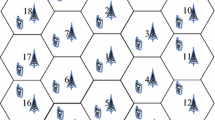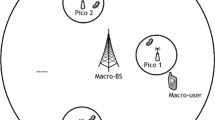Abstract
This paper investigates minimum mean square error (MMSE) with asynchronous interference mitigation in cooperative base station systems. We consider the asynchronous transmission because of the different propagation times between the base station (BS) and mobile stations (BSs). Meanwhile, the channel quantization errors duo to channel quantization is taken into account in our analysis. The proposed scheme is robust to asynchronous interference and channel quantization errors in BSs cooperation systems. Simulations results show that proposed MMSE scheme achieve an improved performance compared with the conventional MMSE in BSs cooperative systems.




Similar content being viewed by others
References
Foschini, G. J., & Gans, M. J. (1998). On the limits of wireless communications in a fading environment when using multiple antennas. Wireless personal communications, 6, 311–335.
Dai, H., Molisch, A. F., & Poor, H. V. (Mar. 2004). Downlink capacity of interference-limited MIMO systems with joint detection. Wireless Communications, IEEE Transactions, 3, 442–453.
Catreux, S., Driessen, P., & Greenstein, L. (Aug. 2001). Attainable throughput of an interference-limited multiple-inputmultiple-output (MIMO) cellular system. IEEE Transactions Communications, 49, 1307–1311.
Ng, B. L., Evans, J. S., Hanly, S. V., & Aktas, D. (Dec. 2008). Distributed downlink beamforming with cooperative base stations. IEEE Transactions on Information Theory, 54(12), 5491–5499.
Costa, M. (May 1983). Writing on dirty paper. Information Theory, IEEE Transactions, 29, 439–441.
Jialing, Li., I-Tai, Lu., Lu, E. (2009). Optimum MMSE transceiver designs for the downlink of multicell MIMO systems Military Communications Conference, IEEE, (pp. 1–7).
Spencer, Q. H., Swindlehurst, A. L., & Haardt, M. (Feb. 2004). Zero-forcing methods for downlink spatial multiplexing in multi-user MIMO channels. Signal Processing, IEEE Transactions, 52, 461–471.
Pan, Z., Wong, K. K., & Ng, T. S. (Nov. 2004). Generalized multiuser orthogonal space-division multiplexing. Wireless Communications, IEEE Transactions, 3(6), 1969–1973.
Jindal, N. (2006). MIMO Broadcast channels with finite rate feedback. Theory : IEEE Transaction (on Inform).
Ravindran, N., & Jindal, N. (2008). Limited feedback-based block diago- nalization for the MIMO broadcast channel, Selected Areas in Communications, IEEE Journal, 26(8) .
Shi, J., Zhang, T., & Zeng, Z. (2011). Rate loss caused by limited feedback and channel delay in coordinated multi-point system, IEEE VTC Spring.
Bhagavatula, R., & Heath, R.W. (2011 ). Adaptive bit partitioning for multi cell intercell interference nulling with delayed limited feedback signal processing, IEEE Transactions on Issue Date: 59(8) (pp. 3824–3836)
Zhang,H., Mehta, N. B., & Molisch, A. F. (2008). Asynchronous interference mitigation in cooperative base station systems, Wireless Communications, IEEE, Transactions (pp. 155–165).
Acknowledgments
The authors would like to thank the reviewers for their detailed reviews and constructive comments, which have helped improve the quality of this paper. This work was supported in part by National Science Fund under Grant No. 6087215; Yunnan Research Program of Application Foundation under Grant No. 2009ZC016X, 2011FB035, KKSY20120302; Yunnan Research Program of Science and Technology under Grant No. 2009CA027.
Author information
Authors and Affiliations
Corresponding author
Appendix
Appendix
We can easily get that \({\mathbb {E}}\left\{ {\left\| {s_k } \right\| _F^2 } \right\} =N_t \) and \(\beta ^{-2}\mathrm{E}\left\{ {\left\| {n_k } \right\| _F^2 } \right\} =\beta ^{-2}N_t \). For the third term in (6), we substitute the channel quantization model (3) into (6):
(a) follows that \(\mathbf{S}\) is independent of \(\mathbf{A}\) and \(\mathbf{B}\), and \({\mathbb {E}}[ \mathbf{S} ]=0\) There are two cases in (25), so it can be further calculated as:
The first term in (26), using \(tr(A+B)=tr(A)+tr(B),<7>\) can be rewritten as:
(b) follows that \(\mathbf{A}_k =(\mathbf{I}_{N_r } -\mathbf{Z}_k^H \mathbf{Z}_k )^{1/2}\mathbf{R}_k \), it further can be expressed as:
\(<7>\) follows \({\mathbb {E}}\left\{ {\mathbf{RR}^{H}} \right\} =N_t \mathbf{I}_{N_r } \) and \({\mathbb {E}}\left\{ {\mathbf{Z}_k \mathbf{Z}_{_k }^H } \right\} =\frac{D}{N_r }\mathbf{I}_{N_r } \).
The fourth term in (6) can be calculated by:
The fifth and sixth in (6) can be further calculated by:
(c) follows that \(\mathbf{H}_{k}={\hat{\mathbf{H}}}_k\mathbf{A}_k +\mathbf{S}_k \mathbf{B}_k \) and (d) comes from \(\mathbf{S}\) is independent of \(\mathbf{A}\) and \(\mathbf{B}\), and \({\mathbb {E}}\left[ \mathbf{S} \right] =0\). (e) holds because \({\mathbb {E}}\left( \mathbf{A} \right) ={\mathbb {E}}\left( {\left( {\mathbf{I}_{N_r } -\mathbf{Z}_k^H \mathbf{Z}_k } \right) ^{1/2}\mathbf{R}_k } \right) =\psi \mathbf{I}_{N_r } \).
Rights and permissions
About this article
Cite this article
Tang, J., Zhao, K., Ni, C. et al. Robust MMSE Design With Asynchronous Interference Mitigation in Cooperative Base Station Systems. Wireless Pers Commun 78, 889–903 (2014). https://doi.org/10.1007/s11277-014-1790-3
Published:
Issue Date:
DOI: https://doi.org/10.1007/s11277-014-1790-3




